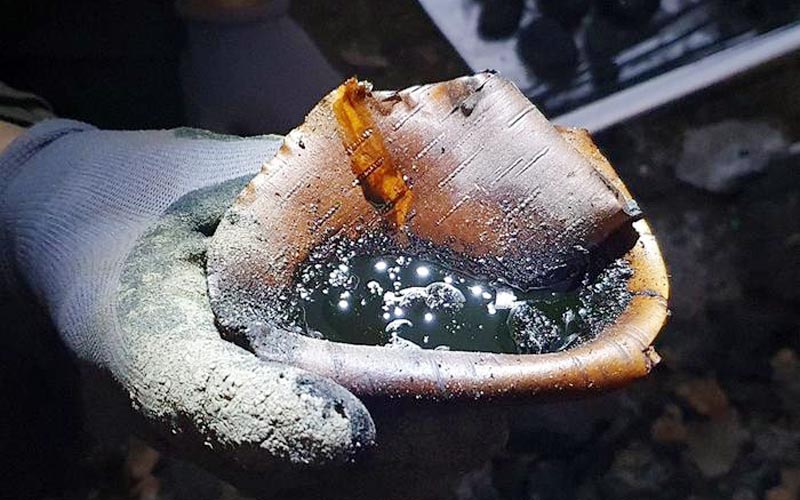
New Insights Into Prehistoric Cognition Through Adhesive Modelling

Raised structure tar – Birch bark tar vessel containing hot tar from a recently completed experiment using the ‘raised structure’ technique.
Photo credit: Geeske Langejans
Studying prehistoric production processes of birch bark tar using computational modelling reveals what kinds of cognition were required for the materials produced by Neanderthal and early modern humans. Researchers of Team Langejans in the Materials Science and Engineering (MSE) department (TU Delft) recently published two papers on one of the world’s oldest transformative technologies, publishing their findings in Nature Scientific Reports.
Measuring complexity
Birch bark tar is the first time we see evidence of creating a new material, said Dr. Paul Kozowyk, lead author on one of the papers. Examining the methods used to create the tar is an important step in understanding the behaviours and technical cognition required by the Neanderthals. Using Petri net models, a formal modelling language, Dr. Sebastian Fajardo led a study looking at various production methods, using metrics from existing literature to measure complexity. “Neanderthals used, at least on some occasions, a complex production process to make tar. To do that they needed ways to deal with a lot of information, like understanding and a way to transmit information very well,” he said. The findings from the study suggest that Neanderthals probably relied on several cognitive traits that archaeologists often associate with modern thinking and behaviour.
Scaling up
Taking one of the metrics Fajardo used, Kozowyk applied it in more detail to one of the tar production techniques to explore how scaling up a technological process affects its complexity. “The outcome in this case was that it has a very significant impact on the complexity and that suggests people had a way to deal with this complex upscaling,” he said. That might involve inventing a different method or working together as a group which requires more communication. “We don’t prove that they were using a particular method, but our findings show that regardless of the methods employed, prehistoric tar making likely required a level of information processing that extended beyond simple behaviours.”
Materials then and now
Archaeological research has found a niche at the TU Delft, and Fajardo said it all comes down to analysing materials. “For example, at 3mE we try to find new materials,” he noted. “We try to understand how these new materials were produced in the past because if we understand how the first human-made materials were created, we can also start to identify human conditions we need to make new materials now with the resources that we have.” For Kozowyk, whose research is mostly experimental, it’s about looking at the material properties of the adhesives to try to understand the decisions that people made in the past. “A lot of my experiments involve mechanical testing of the materials so this is the right place to be.”
This research is part of the Ancient Adhesives project, funded by the European Research Council (ERC) under the European Union’s Horizon 2020 research and innovation programme (Grant agreement No. 804151).
Journal: Scientific Reports
DOI: 10.1038/s41598-023-42078-1
Method of Research: Randomized controlled/clinical trial
Subject of Research: Not applicable
Article Title: Measuring ancient technological complexity and its cognitive implications using Petri nets
Article Publication Date: 22-Sep-2023
Media Contact
Pauline Bijster
Delft University of Technology
h.p.bijster@tudelft.nl









![[1] Key Research Findings on Transfer-Printed Alumina–Gold Dual-layer Protective Coating](https://www.innovations-report.com/wp-content/uploads/2025/07/Transfer_printing_technology_for_lithium_protectiv_1753252750-e1753252940671-362x245.jpg)


